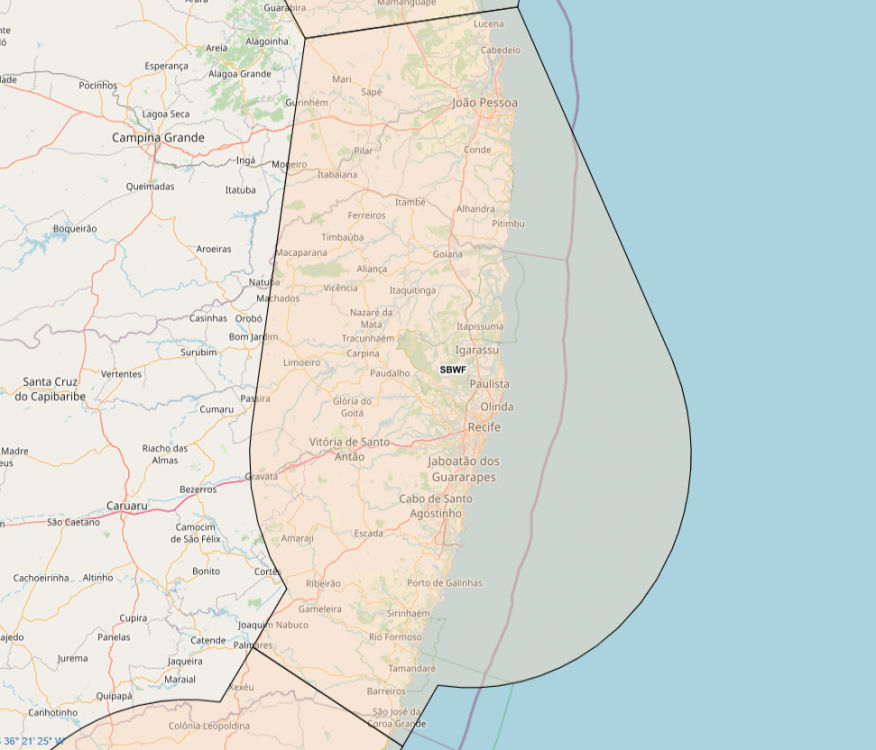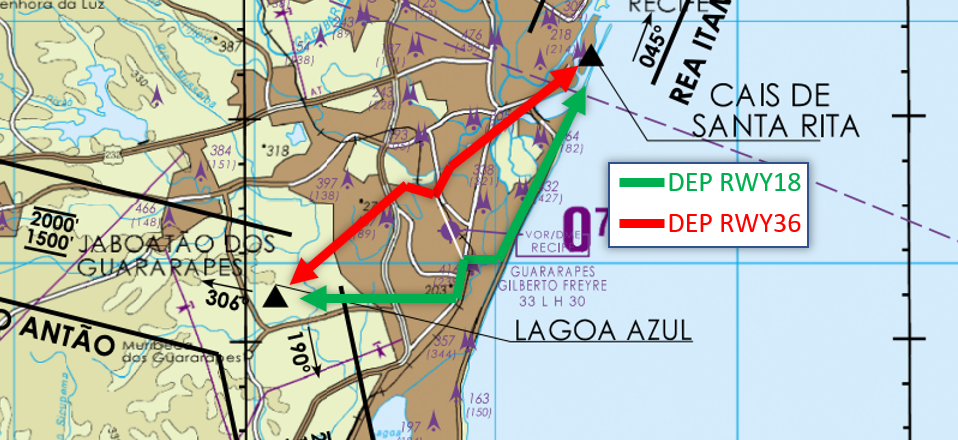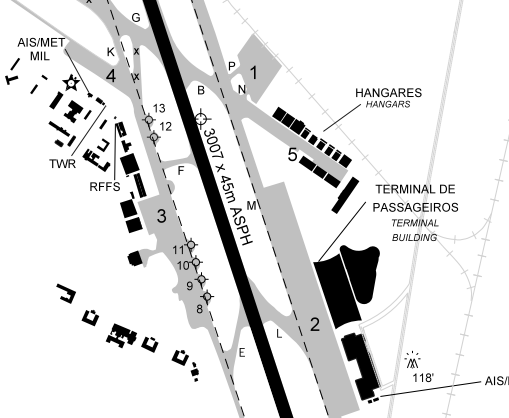Brazil Division
| ICAO | Name | ATC Facilities | SSR | Type of Operation |
|---|---|---|---|---|
| SBRF | Guararapes - Gilberto Freyre | TWR / GND / DEL | 0201-0210 | VFR / IFR |
This document describes th e procedures that must be followed by the Air Traffic Service (ATS) at Guararapes Airport. The procedures described here are supplementary to the DECEA procedures.
Scope
Those procedures must be followed and applied by all members that are operating at SBRF. Especially the ATC, but not exclusive.
Procedural deviations
Exceptional situations, or unusual ones, can necessitate procedural deviations, or complementary procedures, to be added to the following procedures described in this document.
| Facility | Callsign | Frequência | ID |
| Tower | Recife Tower | 118.350 | RF1 |
| Ground | Recife Ground | 121.850 | RF2 |
| Clearance | Recife Clearance | 118.900 | RF3 |
| ATIS | ATIS | 127.650 | ATIS |
| Facility | Callsign | Frequency | ID |
| Control | Recife Control | 119.500 | WF1 |
| Facility | Callsign | Frequency | ID |
| Center | Recife Center | 125.400¹ | RE1 |
| 128.800² |
¹ - primary frequency
² - secondary frequency
The departing VFR aircraft always will be cleared, after leaving the traffic pattern, to fly DCT to CAIS DE SANTA RITA position (to joing at ITAMARACA corridor), or to LAGOA AZUL position (to joing at VITORIA DE SANTO ANTAO corridor, or SUAPE corridor).
ONLY after coordination between RECIFE TWR and APP (or ACC, if the APP is offline), an aircraft can be cleared to fly to another position after departure.
WINGSPAM limitation
The ATC must observe the following TWY limitations:
- MAX SPAM allowed 36 meters on TWY G and K;
- MAX SPAM allowed 15 meters on TWY P and N.
Turnaround over the runway
Turnaround of 180DEG of ACFT type of FOKKER 100, BOEING 737, or greater, only on THR
Civilian ACFT restriction
The RF TWR must observe the prohibition imposed to civilian ACFT to circle on west side of the airport (see the image at the side).
Simultaneous operations on the RWY and paralelal TWY
When SBRF is operating under IMC, the simultaneous operation of landing and departure on RWY18/36 and taxi on TWY D, K and M is PROHIBITED; between an ACFT with wingspam of 36 meters, or greater, and other ACFT with SPAM of 24 meters or greater.
Example: an Azul A330 (60 meters of WINGSPAM) landing on RWY18, and a Gol B737 (36 meters of WINGSPAM) requesting taxi on TWY M. How an ACFT has more than 36 meters of WINGSPAM, and the other one has more than 24 meters, this operation can't be occurs. So, the Gol's 737 has to wait the Azul's A330 landing before can be start the taxi.
It's important the ATC notes this restriction complexity. To avoid excessive penalties, or unnecessary fuel burn, pushback and startup requests must be denied until the wait time is no longer than the minimally acceptable.
Hangars
Observe the map on the side to know the SBRF hangar location. Their names can be used during the communications to facilitate the parking indication.
Parking Position
The following criterias must be observed to determine the parking positions of an ACFT:
- APRON 1
- Small and Medium GENERAL AVIATION that won't go to a Hangar;
- Small commercial ACFT;
- Helicopters won't go to a Hangar.
- APRON 2
- Large and Medium commercial ACFT;
- Large General Aviation;
- Cargo ACFT.
- APRON 3 and 4
- Military ACFT.
When an ACFT goes to APRON 2, the RF TWR will determine an specific parking position. So, follow those criterias:
Flight Type Does ACFT uses finger? International Size Positions Commercial No No Any 1 to 5 Yes Medium 6 to 13 Large 10 and 13
Yes Medium 14 to 16 Yes Large 16 General No Any Large 1 to 5 Cargo No Any Any 17 to 21 How we don't have numbers printed on Aprons 1, 3 and 4 PDC, the expression "position at your discretion" must be used, following this example:
TWR -> PSEYA, on the ground at 03', vacate the runway to the left and taxi via B and P to apron 1, position at your discretion.
Instruction after landing
When an ACFT is on final, the TWR RF must ask about the parking position ACFT. So, the TWR must forward this information to the RF GND.
Depending on the parking location that the aircraft goes to and the TWY that ACFT will vacate the runway, to minimize crew workload, and accelerate the vacate of the runway, the TWR RF will authorize the ACFT taxi without transferring the communication to the GND RF. For this, it is extremely necessary, and INDISPENSABLE, that there is constant coordination between TWR and GND.
In an attempt to standardize some situations in which this will occur, TWR and GND must meet the following criteria:
Conflicting traffic on TWY? TWY vacated via Parking position Must transfer to the GND? YES Any Any YES NO C Any YES L Apron 2 (position 6 to 15) NO B Apron 1 and Hangars M Any YES D E F Apron 3 NO G Apron 4 J Any YES Any other case that is not broken down in the table above should follow the standard procedure (transfer to the GND after vacating the RWY). It is important to emphasize that the most important thing in these cases is close and continuous coordination between positions.
Note: In the cases mentioned in the table, when the ACFT vacates the RWY, the communication transfer is not made (the ACFT remains in the TWR frequency), however, the control transfer yes (the ACFT is now controlled by GND RF). Therefore, the final word will always be GND RF, since this is who owns the Control of ACFT, even if the communication is still with TWR.
How the TWR must proceed:
- ACFT on final
- Inform the GND RF what is the parking position informed by the pilot;
- If the aircraft goes to the apron 2, the GND RF is who will determine the parking position, following the table in this document;
- When the aircraft lands, the TWR RF will inform:
- callsign;
- landing time;
- TWR to vacate via;
- TWR to taxi to the parking position (if it is different from the vacating TWY);
- parking position (or "position at your discretion", following the specif cases in this document); and
- reinforce that the ACFT should remain on the TWR listening until cutoff (to prevent the crew from changing the frequency without being instructed to do so).
TWR RF -> AZU4224, on the ground at 54', vacate via L taxiway, and proceed via M to stand 9. Remain on my frequency until the cutoff.
Clearance to depart from an intermediate position of RWY
Following a DECEA instruction, always that a clearance/suggestion to depart from an intermediate position is given, the ATC must inform the remaining runway length from that position. To this, observe the image below:
Coordination with the APP WF
Ever that the traffic is flying on SBRF traffic pattern, and the WF APP is online, the 360º maneuvering on the downwind leg or extending the downwind leg must be coordinated with APP.
Restrictions on Traffic Pattern
Normally, the ARRIVALS to the traffic pattern will be done by the following positions:
- Cais de Santa Rita;
- Lagoa Azul; or
- other position previously coordinated between APP and TWR
The DEPARTURES will obey what is contained in this chapter, in VFR DEPARTURES.
Next controller online
The departing VFR aircraft will be instructed to contact WF APP, or RE ACC, when joining the corridor, after leaving the traffic pattern.
NOTE: the handoff can occur at another point, as long as previously coordinated between the TWR and APP (or ACC, when APP is offline).
Next controller offline
If the WF APP, or RE ACC, is offline, the TWR must authorize the frequency change, after the traffic leaving the RECIFE CTR, following this example:
Pilot -> Recife Tower, PTOZZ, passing FORTE ORANGE position.
Tower -> PTOZZ, the next controller is offline, frequency change approved.
Use ever the AISWEB to check the active NOTAM.
NOTE: What must prevail ever is common sense. If the pilot asks not to simulate a NOTAM, and this won't disturb other simmers, this request MUST BE attended! Punctual issues must be reported to our staff team.
Ever the wind intensity at SBRF is less or equal at 5kt, the RWY18 must be used as PREFERENTIAL. Except in the cases that operational gains can be provided, and be previously coordinated with WF APP, the RWY36 can be used in this case.
Follow those rules when an IFR aircraft starts the missed approach procedure:
- coordinate IMMEDIATELY with the APP, or ACC (when the APP is offline), when the TWR notes an aircraft is starting the missed approach;
- don't change, UNDER ANY CIRCUMSTANCES, the missed approach procedure; unless the pilot declares intentions to join in the traffic pattern;
- handoff the traffic to APP, or to ACC (when APP is offline), or authorize "frequency change approved" (when Next Controller is offline), ASAP;
- understand the crew workload during this procedure can be increased; causing delayed answers by the pilots.
The Tower only can receive a flight plan via radio to the SAR operation aircraft, and others one provided for in official DECEA regulation.
NOTE: It equates to Operation SAR, the aircraft on a radio patrol mission.
Due to POSCON limitation, SBRF doesn't have ATIS; so, the TWR must give meteorological information to all departing aircraft, with the following information, and in this sort:
- runway in use;
- wind direction and intensity;
- QNH
- temperature
- visibility, or runway in use RVR; and
- time check
Example:
GLO1817, runway in use 18, wind 1-4-0º, 8KT, altimeter setting 1-0-1-2, temperature 2-8º, visibility 8km, time check 5-6'.
| # | Date | Description | Author |
|---|---|---|---|
| - | 18ABR22 | Criação do documento | Juvenal Gomes (1025243) |




